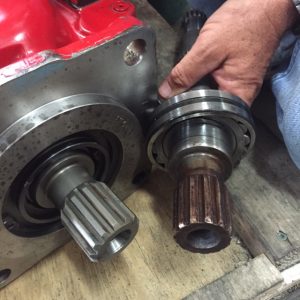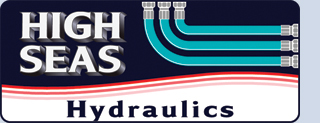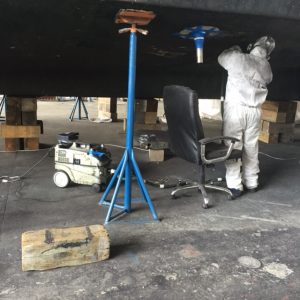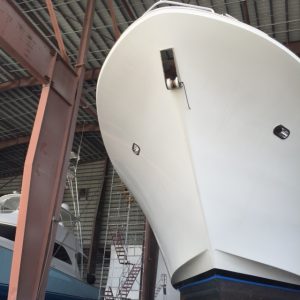Our Hydraulics team was recently called upon to work on a PTO (power take-off) pump that was driven off the vessel’s main engine transmissions.
 Removal of the pump was extremely difficult due to corrosion between the pump shaft splines and the coupling. The corrosion was due to exposure to saltwater and normal wear and tear. In the marine business, the internal and external splines that make up the coupling usually reside on different pieces of equipment supplied by different vendors. The SAE Involute spline standards are the most commonly used for shaft diameters between ½” and 2”. The tolerances are loose enough to insure multi-vendor interchangeability while still providing torque transmission significantly higher than a keyed coupling. The tight fit avoids any lash and excessive wear in the splines over the life of the pump. There are many benefits in using spline shafts in place of a keyed shaft for this application. The spline connection offers a load distribution which is equal along the teeth sides enabling both to rotate together. Consequently, this load produces a longer fatigue life compared to the keyway drive.
Removal of the pump was extremely difficult due to corrosion between the pump shaft splines and the coupling. The corrosion was due to exposure to saltwater and normal wear and tear. In the marine business, the internal and external splines that make up the coupling usually reside on different pieces of equipment supplied by different vendors. The SAE Involute spline standards are the most commonly used for shaft diameters between ½” and 2”. The tolerances are loose enough to insure multi-vendor interchangeability while still providing torque transmission significantly higher than a keyed coupling. The tight fit avoids any lash and excessive wear in the splines over the life of the pump. There are many benefits in using spline shafts in place of a keyed shaft for this application. The spline connection offers a load distribution which is equal along the teeth sides enabling both to rotate together. Consequently, this load produces a longer fatigue life compared to the keyway drive.
In this case, the corrosion had damaged the spline surfaces and locked the two parts together. What would normally take a couple of hours, ended up taking almost two days to complete. Once finally removed, it was apparent that splines were damaged beyond repair. The only solution was rebuilding the pump with a new shaft and the correct size splines. Splines come in many different sizes and types, so replacement must be an exact match.
Once the pump was rebuilt, we re-assembled with the main engine transmission and installed it back in the boat. By rebuilding the pump, we saved the captain thousands of dollars.





 Our running gear mechanics inspected the shafts to ensure they were straight and aligned and replaced the bearings and seals. Normal wear and tear associated with running the vessel and prolonged exposure to salt water makes this task a necessary evil for properly maintaining the boat. As seen in the adjacent photo, there was a visible gap where the cutlass bearing adjoined to the shaft.
Our running gear mechanics inspected the shafts to ensure they were straight and aligned and replaced the bearings and seals. Normal wear and tear associated with running the vessel and prolonged exposure to salt water makes this task a necessary evil for properly maintaining the boat. As seen in the adjacent photo, there was a visible gap where the cutlass bearing adjoined to the shaft. recommends changing the lower stabilizer fin seals every couple of years but at least every six years depending on use. The components on the stabilizer are constantly working except is absolute calm seas, so the wear and tear can be considerable. After dropping the fins, we proceeded to change out the old lower stabilizer fin seals with new ones, check the hoses and cylinders, then reassembling the units.
recommends changing the lower stabilizer fin seals every couple of years but at least every six years depending on use. The components on the stabilizer are constantly working except is absolute calm seas, so the wear and tear can be considerable. After dropping the fins, we proceeded to change out the old lower stabilizer fin seals with new ones, check the hoses and cylinders, then reassembling the units. To round out the work on this Westport, we did an overhaul on the bow thruster, single Maxwell windlass, the boat’s heat exchangers and the hydraulic steering system which was slow to respond.
To round out the work on this Westport, we did an overhaul on the bow thruster, single Maxwell windlass, the boat’s heat exchangers and the hydraulic steering system which was slow to respond.